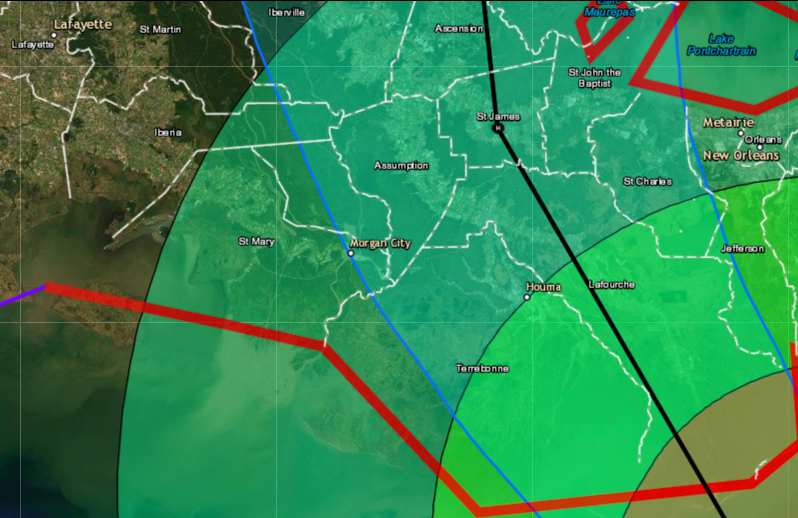10 a.m. UPDATE: Hurricane Ida nearing coast, glances over Southwest Pass
Published 10:22 am Sunday, August 29, 2021

- Hurricane Ida, 082921 1000
Hurricane Ida is on the verge of making landfall in Louisiana as a Category 4 storm that has gusts pushing it close to a Category 5 status, according to the latest update from the National Hurricane Center.
According to its 10 a.m. update, the NHC reports that Ida’s rapid strengthening appears to have leveled off within the past hour or so. NOAA and Air Force Reserve Hurricane Hunter aircraft that have been in the storm this morning have reported peak flight-level winds of 146 to 148 kt between 8000 and 10,000 feet, and believable SFMR winds around 130 kt. Based on these observations, the initial wind speed remains 130 kt for this advisory.
The central pressure appears to have bottomed out around 929 mb, and the latest dropsonde in the eye from the Air Force plane supports a minimum pressure of 933 mb. Ida’s satellite and radar presentation is very impressive, as the 15-nautical-mile-wide eye is very well-defined and surrounded by a ring of intense convection.
Within the past hour or so, there is evidence in radar imagery of a secondary eyewall, and this has likely caused Ida’s intensity to level off for now. Although Ida’s extreme winds are confined to the inner eyewall, the aircraft data indicate that hurricane-force winds extend outward about 45 nautical miles to the northeast of the center, and based on buoy data the tropical-storm-force wind field extends outward about 130 n mi northeast of the center.
Ida’s eyewall is nearing the coast of Louisiana, and any additional strengthening seems less likely now given the recent structural changes of the inner core. According to the National Hurricane Center, the eyewall was actually over the Mississippi Delta at Southwest Pass around 9:30 a.m,
While rapid weakening should occur after landfall, damaging winds will penetrate well inland across southeastern Louisiana and southwestern Mississippi through tonight. Ida is forecast to weaken to a tropical depression over Mississippi by late Tuesday. The global model guidance now indicates that Ida will likely transition to an extratropical low when it nears the east coast of the United States and the new forecast shows the extratropical low becoming a gale center near Atlantic Canada at day 5.
Ida has begun to slow down according to the latest aircraft and radar fixes, and the initial motion estimate is 320/11 kt. Ida’s forward speed is likely to slow further during the next 12 to 24 hours as the hurricane turns north-northwestward, and then northward around the western periphery of a deep-layer ridge near the southeastern United States coast.
The cyclone is predicted to turn northeastward by late Tuesday ahead of a short-wave trough that will move across the central United States. The new NHC track is close to the HCCA corrected consensus and the GFS ensemble mean, and is not very different from the previous advisory.
Key Messages:
1. Extremely life-threatening storm surge inundation of 9 feet or greater above ground level is imminent somewhere within the area from Burns Point, Louisiana, to Ocean Springs, Mississippi. Overtopping of local levees outside of the Hurricane and Storm Damage Risk Reduction System is possible where local inundation values may be higher.
2. Catastrophic wind damage will occur where the core of Ida moves onshore along the southeast coast of Louisiana in the next few hours. Hurricane-force winds and damaging wind gusts are expected today within the Hurricane Warning in southeastern Louisiana, including metropolitan New Orleans.
3. Damaging winds, especially in gusts, will spread inland near the track of the center of Ida into southwestern Mississippi tonight and early Monday. These winds will likely lead to widespread tree damage and power outages.
4. Ida will continue to produce heavy rainfall today through Monday across the central Gulf Coast from southeast Louisiana, coastal Mississippi, and far southwestern Alabama, resulting in considerable to life-threatening flash and urban flooding and significant river flooding impacts. As Ida moves inland, significant flooding impacts are possible across portions of the Lower Mississippi, Tennessee Valley, Upper Ohio Valley, Central Appalachians and the Mid-Atlantic through Wednesday.





